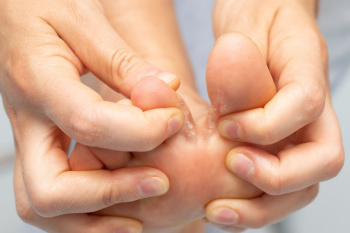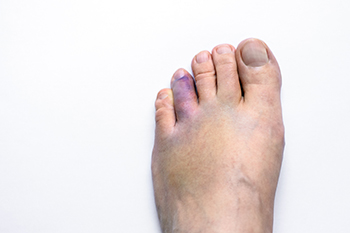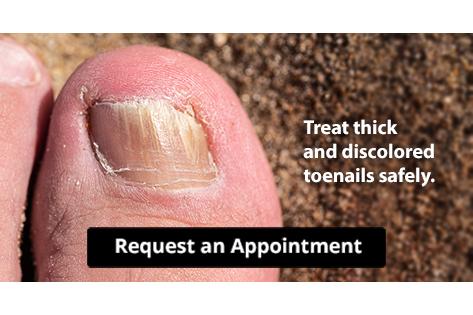Blogs
Causes of Nerve Pain in the Feet

Nerve pain in the feet often develops when the nerves that carry signals from the spine to the toes become damaged or compressed. This pain can feel like burning, tingling, numbness, or electric-like shocks. Problems in the lower back, such as a herniated disc or spinal stenosis, can irritate nerves that extend into the feet. Peripheral neuropathy, which occurs when nerves in the legs or feet themselves are injured, can also lead to discomfort, weakness, and loss of sensation. Diabetes, traumatic injuries, and prolonged pressure on the feet can all contribute to nerve damage. Footwear that lacks adequate support, repetitive strain, or prolonged standing can worsen symptoms by increasing nerve compression. A podiatrist can perform diagnostic tests to locate the source of the pain and provide treatment that helps protect nerve health and restore comfort. If you have symptoms of nerve pain in the feet, it is suggested that you schedule an appointment with a podiatrist for a diagnosis and appropriate treatment options.
Neuropathy
Neuropathy can be a potentially serious condition, especially if it is left undiagnosed. If you have any concerns that you may be experiencing nerve loss in your feet, consult with One of our podiatrists from Taub Podiatry. Our doctors will assess your condition and provide you with quality foot and ankle treatment for neuropathy.
What Is Neuropathy?
Neuropathy is a condition that leads to damage to the nerves in the body. Peripheral neuropathy, or neuropathy that affects your peripheral nervous system, usually occurs in the feet. Neuropathy can be triggered by a number of different causes. Such causes include diabetes, infections, cancers, disorders, and toxic substances.
Symptoms of Neuropathy Include:
- Numbness
- Sensation loss
- Prickling and tingling sensations
- Throbbing, freezing, burning pains
- Muscle weakness
Those with diabetes are at serious risk due to being unable to feel an ulcer on their feet. Diabetics usually also suffer from poor blood circulation. This can lead to the wound not healing, infections occurring, and the limb may have to be amputated.
Treatment
To treat neuropathy in the foot, podiatrists will first diagnose the cause of the neuropathy. Figuring out the underlying cause of the neuropathy will allow the podiatrist to prescribe the best treatment, whether it be caused by diabetes, toxic substance exposure, infection, etc. If the nerve has not died, then it’s possible that sensation may be able to return to the foot.
Pain medication may be issued for pain. Electrical nerve stimulation can be used to stimulate nerves. If the neuropathy is caused from pressure on the nerves, then surgery may be necessary.
If you have any questions, please feel free to contact our offices located in Stuart, Port St. Lucie, and Hobe Sound, FL . We offer the newest diagnostic and treatment technologies for all your foot care needs.
Inspect Your Feet Regularly for Abnormalities if You're Diabetic
Pros and Cons of Diabetic Foot Offloading Devices

Diabetic offloading devices are designed to reduce pressure on areas of the feet that are vulnerable to ulcers, especially the heels, toes, and forefoot. These devices include specialized boots, casts, and orthotic inserts that redistribute weight away from high-pressure points, allowing wounds to heal more effectively. A benefit is that they protect sensitive areas from repetitive stress and friction, which lowers the risk of infections that can lead to limb loss. They also encourage proper alignment, helping reduce strain on surrounding joints and soft tissue. However, some off-loading devices can have drawbacks, such as limited mobility, difficulty fitting into regular shoes, or discomfort, if not properly adjusted. Some people may also find them bulky, which affects daily activities. A podiatrist can determine the most appropriate device, monitor its effectiveness, and adjust it as needed to prevent further complications. If you have diabetes and have developed foot pain, t is strongly suggested that you are under the care of a podiatrist who can help you to manage this serious condition.
Diabetic foot care is important in preventing foot ailments such as ulcers. If you are suffering from diabetes or have any other concerns about your feet, contact One of our podiatrists from Taub Podiatry. Our doctors can provide the care you need to keep you pain-free and on your feet.
Diabetic Foot Care
Diabetes affects millions of people every year. The condition can damage blood vessels in many parts of the body, especially the feet. Because of this, taking care of your feet is essential if you have diabetes, and having a podiatrist help monitor your foot health is highly recommended.
The Importance of Caring for Your Feet
- Routinely inspect your feet for bruises or sores.
- Wear socks that fit your feet comfortably.
- Wear comfortable shoes that provide adequate support.
Patients with diabetes should have their doctor monitor their blood levels, as blood sugar levels play such a huge role in diabetic care. Monitoring these levels on a regular basis is highly advised.
It is always best to inform your healthcare professional of any concerns you may have regarding your feet, especially for diabetic patients. Early treatment and routine foot examinations are keys to maintaining proper health, especially because severe complications can arise if proper treatment is not applied.
If you have any questions, please feel free to contact our offices located in Stuart, Port St. Lucie, and Hobe Sound, FL . We offer the newest diagnostic and treatment technologies for all your foot care needs.
Three Conditions That Affect the Big Toe Joint

The big toe joint, known as the first metatarsophalangeal, or MTP, joint, connects the toe bones to the foot and supports body weight with each step. Because of this constant stress, it is vulnerable to several conditions. Bunions may develop when the big toe shifts toward the second toe, often causing pain and deformity. Turf toe occurs when the big toe is forced upward, straining ligaments and tissues surrounding the joint. Osteoarthritis may result from long-term wear and tear, while inflammatory arthritis can cause stiffness, swelling, and deformities. Additionally, gout may strike suddenly, producing severe pain, redness, and swelling when uric acid crystals collect within the joint. Infections, including septic arthritis, can also lead to rapid big toe joint damage and require prompt care. A podiatrist can provide treatment options including wearing supportive footwear, and even surgery, in serious cases. If you have ongoing pain in the big toe joint, it is suggested that you schedule an appointment with a podiatrist for an exam and appropriate treatment.
Toe pain can disrupt your daily activities. If you have any concerns, contact One of our podiatrists of Taub Podiatry. Our doctors can provide the care you need to keep you pain-free and on your feet.
What Causes Toe Pain?
Most severe toe pain is caused due to a sports injury, trauma from dropping something heavy on the toe, or bumping into something rigid. Other problems can develop over time for various reasons.
Toe pain can be caused by one or more ailments. The most common include:
- Trauma
- Sports injury
- Wearing shoes that are too tight
- Arthritis
- Gout
- Corns and calluses
- Hammertoe
- Bunions
- Blisters
- Ingrown toenails
- Sprains
- Fractures (broken bones)
- Dislocations
When to See a Podiatrist
- Severe pain
- Persistent pain that lasts more than a week
- Signs of infection
- Continued swelling
- Pain that prevents walking
Diagnosis
In many cases the cause of toe pain is obvious, but in others, a podiatrist may want to use more advanced methods to determine the problem. These can range from simple visual inspections and sensation tests to X-rays and MRI scans. Prior medical history, family medical history, and any recent physical traumatic events will all be taken into consideration for a proper diagnosis.
Treatment
Treatments for toe pain and injuries vary and may include shoe inserts, padding, taping, medicines, injections, and in some cases, surgery. If you believe that you have broken a toe, please see a podiatrist as soon as possible.
If you have any questions please contact our offices located in Stuart, Port St. Lucie, and Hobe Sound, FL . We offer the newest diagnostic and treatment technologies for all your foot and ankle needs.
Signs and Causes of Ankle Sprains

An ankle sprain occurs when the ligaments that stabilize the ankle stretch or tear, often following a twist, fall, or sudden blow to the joint. Ligaments connect bones together, and, when damaged, they can cause significant pain and limit mobility. Signs of an ankle sprain include swelling, bruising, sudden sharp pain, difficulty bearing weight, and, in severe cases, a popping sound at the time of injury. Some sprains may make the ankle feel unstable or cause it to give out while walking. Sprains range in severity from mild stretching of ligaments to complete tears, and symptoms may resemble those of a fracture, making diagnosis by a podiatrist important. Repeated sprains are more likely if the first injury does not heal properly. A podiatrist can perform an exam, order imaging if needed, and recommend proper treatment. If you have symptoms of an ankle sprain, it is suggested that you schedule an appointment with a podiatrist.
Ankle sprains are common but need immediate attention. If you need your feet checked, contact One of our podiatrists from Taub Podiatry. Our doctors can provide the care you need to keep you pain-free and on your feet.
How Does an Ankle Sprain Occur?
Ankle sprains take place when the ligaments in your ankle are torn or stretched beyond their limits. There are multiple ways that the ankle can become injured, including twisting or rolling over onto your ankle, putting undue stress on it, or causing trauma to the ankle itself.
What Are the Symptoms?
- Mild to moderate bruising
- Limited mobility
- Swelling
- Discoloration of the skin (depending on severity)
Preventing a Sprain
- Wearing appropriate shoes for the occasion
- Stretching before exercises and sports
- Knowing your limits
Treatment of a Sprain
Treatment of a sprain depends on the severity. Many times, people are told to rest and remain off their feet completely, while others are given an air cast. If the sprain is very severe, surgery may be required.
If you have suffered an ankle sprain previously, you may want to consider additional support such as a brace and regular exercises to strengthen the ankle.
If you have any questions please feel free to contact our offices located in Stuart, Port St. Lucie, and Hobe Sound, FL . We offer the newest diagnostic tools and technology to treat your foot and ankle needs.
Symptoms and Treatment of Athlete’s Foot

Athlete’s foot, also called tinea pedis, is a fungal infection that commonly affects the skin on the feet. It often begins between the toes, where moisture and warmth allow fungi to thrive. Symptoms of athlete’s foot include itching, redness, peeling, and a scaly buildup on the skin. In some cases, painful cracks or fluid-filled blisters may develop, and the soles of the feet thicken over time. Untreated athlete’s foot can lead to secondary bacterial infections, especially when skin breakdown occurs. People who wear tight shoes or frequently walk barefoot in communal areas, like locker rooms or showers, are more at risk. A podiatrist can examine the affected area and confirm the diagnosis, sometimes with a skin scraping for microscopic evaluation. Treatment includes antifungal medication applied directly to the feet, or, in some cases, taken orally. If you have symptoms of athlete's foot, it is suggested that you schedule an appointment with a podiatrist for an exam and appropriate treatment.
Athlete’s foot is an inconvenient condition that can be easily reduced with the proper treatment. If you have any concerns about your feet and ankles, contact One of our podiatrists from Taub Podiatry. Our doctors will treat your foot and ankle needs.
Athlete’s Foot: The Sole Story
Athlete's foot, also known as tinea pedis, can be an extremely contagious foot infection. It is commonly contracted in public changing areas and bathrooms, dormitory style living quarters, around locker rooms and public swimming pools, or anywhere your feet often come into contact with other people.
Solutions to Combat Athlete’s Foot
- Hydrate your feet by using lotion
- Exfoliate
- Buff off nails
- Use of anti-fungal products
- Examine your feet and visit your doctor if any suspicious blisters or cuts develop
Athlete’s foot can cause many irritating symptoms such as dry and flaking skin, itching, and redness. Some more severe symptoms can include bleeding and cracked skin, intense itching and burning, and even pain when walking. In the worst cases, Athlete’s foot can cause blistering as well. Speak to your podiatrist for a better understanding of the different causes of Athlete’s foot, as well as help in determining which treatment options are best for you.
If you have any questions please feel free to contact our offices located in Stuart, Port St. Lucie, and Hobe Sound, FL . We offer the newest diagnostic and treatment technologies for all your foot and ankle needs.
Common Foot and Ankle Injuries in Windsurfing

Windsurfing is an exciting sport, but it places the feet and ankles at risk for a variety of injuries. Collisions with the board can cause sprains, fractures, or bruising, while striking obstacles in the water may lead to cuts or more serious trauma. The constant pressure of balancing and adjusting foot position can also strain tendons and ligaments, increasing the chance of overuse injuries. A podiatrist can evaluate the extent of damage, provide treatment such as bracing or other procedures. If you experience pain or injury while windsurfing, it is suggested that you schedule a visit with a podiatrist to protect your feet, recover safely, and continue enjoying the sport.
Sports related foot and ankle injuries require proper treatment before players can go back to their regular routines. For more information, contact One of our podiatrists of Taub Podiatry. Our doctors can provide the care you need to keep you pain-free and on your feet.
Sports Related Foot and Ankle Injuries
Foot and ankle injuries are a common occurrence when it comes to athletes of any sport. While many athletes dismiss the initial aches and pains, the truth is that ignoring potential foot and ankle injuries can lead to serious problems. As athletes continue to place pressure and strain the area further, a mild injury can turn into something as serious as a rupture and may lead to a permanent disability. There are many factors that contribute to sports related foot and ankle injuries, which include failure to warm up properly, not providing support or wearing bad footwear. Common injuries and conditions athletes face, including:
- Plantar Fasciitis
- Achilles Tendinitis
- Achilles Tendon Rupture
- Ankle Sprains
Sports related injuries are commonly treated using the RICE method. This includes rest, applying ice to the injured area, compression and elevating the ankle. More serious sprains and injuries may require surgery, which could include arthroscopic and reconstructive surgery. Rehabilitation and therapy may also be required in order to get any recovering athlete to become fully functional again. Any unusual aches and pains an athlete sustains must be evaluated by a licensed, reputable medical professional.
If you have any questions please contact our offices located in Stuart, Port St. Lucie, and Hobe Sound, FL . We offer the newest diagnostic and treatment technologies for all your foot and ankle needs.
Stop Your Toenail Fungus
Reasons for Nighttime Foot Pain

Foot pain may affect the toes, arches, heels, or ankles, and it often becomes more noticeable at night, when the body is at rest. Muscle fatigue from standing or walking for long periods of time, can cause cramps that worsen during sleep. Plantar fasciitis, an inflammation of the tissue that supports the arch, may lead to sharp or throbbing heel pain that persists into the night. Nerve conditions such as Morton’s neuroma or peripheral neuropathy can create burning, tingling, or stabbing pain that interrupts sleep. Circulation problems related to diabetes may also produce aching or cramping when blood flow to the feet is reduced. In some cases, sciatica can cause pain that radiates down into the feet, making nighttime discomfort worse. A podiatrist can determine the source of the foot pain and provide treatment to relieve symptoms and protect long-term foot health. If you frequently experience nighttime foot pain, it is suggested that you schedule an appointment with a podiatrist for an exam and appropriate treatment solutions.
Foot Pain
Foot pain can be extremely painful and debilitating. If you have a foot pain, consult with One of our podiatrists from Taub Podiatry. Our doctors will assess your condition and provide you with quality foot and ankle treatment.
Causes
Foot pain is a very broad condition that could be caused by one or more ailments. The most common include:
- Bunions
- Hammertoes
- Plantar Fasciitis
- Bone Spurs
- Corns
- Tarsal Tunnel Syndrome
- Ingrown Toenails
- Arthritis (such as Gout, Rheumatoid, and Osteoarthritis)
- Flat Feet
- Injury (from stress fractures, broken toe, foot, ankle, Achilles tendon ruptures, and sprains)
- And more
Diagnosis
To figure out the cause of foot pain, podiatrists utilize several different methods. This can range from simple visual inspections and sensation tests to X-rays and MRI scans. Prior medical history, family medical history, and any recent physical traumatic events will all be taken into consideration for a proper diagnosis.
Treatment
Treatment depends upon the cause of the foot pain. Whether it is resting, staying off the foot, or having surgery; podiatrists have a number of treatment options available for foot pain.
If you have any questions, please feel free to contact our offices located in Stuart, Port St. Lucie, and Hobe Sound, FL . We offer the newest diagnostic and treatment technologies for all your foot care needs.
Sesamoiditis and Foot Pain

Sesamoiditis is the inflammation of the small sesamoid bones located beneath the big toe joint that help bear weight and support movement. This condition often develops in athletes, dancers, or anyone placing repeated stress on the ball of the foot. Risk factors include high-impact activities, wearing improper footwear, and foot structure abnormalities. Pain is typically felt under the big toe, especially when walking, running, or bending the toe. Symptoms may include swelling, tenderness, and difficulty pushing off the foot. A podiatrist can provide customized treatment such as rest strategies, orthotics, and targeted exercises. If you have pain in this part of your foot, it is suggested you schedule an appointment with a podiatrist who can accurately diagnose and treat what may be going on.
Sesamoiditis is an unpleasant foot condition characterized by pain in the balls of the feet. If you think you’re struggling with sesamoiditis, contact One of our podiatrists of Taub Podiatry. Our doctors will treat your condition thoroughly and effectively.
Sesamoiditis
Sesamoiditis is a condition of the foot that affects the ball of the foot. It is more common in younger people than it is in older people. It can also occur with people who have begun a new exercise program, since their bodies are adjusting to the new physical regimen. Pain may also be caused by the inflammation of tendons surrounding the bones. It is important to seek treatment in its early stages because if you ignore the pain, this condition can lead to more serious problems such as severe irritation and bone fractures.
Causes of Sesamoiditis
- Sudden increase in activity
- Increase in physically strenuous movement without a proper warm up or build up
- Foot structure: those who have smaller, bonier feet or those with a high arch may be more susceptible
Treatment for sesamoiditis is non-invasive and simple. Doctors may recommend a strict rest period where the patient forgoes most physical activity. This will help give the patient time to heal their feet through limited activity. For serious cases, it is best to speak with your doctor to determine a treatment option that will help your specific needs.
If you have any questions, please feel free to contact our offices located in Stuart, Port St. Lucie, and Hobe Sound, FL . We offer the newest diagnostic and treatment technologies for all your foot care needs.
More...
Types of Broken Toes

Broken toes can range from simple cracks in the bone to more severe fractures that involve joint displacement or multiple bone fragments. These injuries often result from sudden trauma, such as dropping a heavy object on the foot or forcefully striking a hard surface. Common symptoms include sharp pain, swelling, bruising, and difficulty walking, especially if pressure on the affected toe causes discomfort. A toe that appears crooked or shortened compared to its neighbors may indicate a displaced fracture or dislocation. A podiatrist will typically perform a thorough foot exam and may use X-rays to confirm the type and severity of the fracture. If the bone is misaligned or severely broken, surgery may be needed to restore proper toe position and prevent long-term complications. If you have broken a toe, it is suggested that you make an appointment with a podiatrist for an exam and suggested treatment options.
A broken toe can be very painful and lead to complications if not properly fixed. If you have any concerns about your feet, contact One of our podiatrists from Taub Podiatry. Our doctors will treat your foot and ankle needs.
What to Know About a Broken Toe
Although most people try to avoid foot trauma such as banging, stubbing, or dropping heavy objects on their feet, the unfortunate fact is that it is a common occurrence. Given the fact that toes are positioned in front of the feet, they typically sustain the brunt of such trauma. When trauma occurs to a toe, the result can be a painful break (fracture).
Symptoms of a Broken Toe
- Throbbing pain
- Swelling
- Bruising on the skin and toenail
- The inability to move the toe
- Toe appears crooked or disfigured
- Tingling or numbness in the toe
Generally, it is best to stay off of the injured toe with the affected foot elevated.
Severe toe fractures may be treated with a splint, cast, and in some cases, minor surgery. Due to its position and the pressure it endures with daily activity, future complications can occur if the big toe is not properly treated.
If you have any questions, please feel free to contact our offices located in Stuart, Port St. Lucie, and Hobe Sound, FL . We offer the newest diagnostic and treatment technologies for all your foot care needs.
A Trusted Surgical Option for Ingrown Toenails

Ingrown toenails can cause persistent pain, swelling, and infection when the edge of the nail grows into the surrounding skin. While conservative care such as soaking, trimming, or antibiotics may provide temporary relief, some cases require a more lasting solution. One well-established approach is a minor surgical procedure that carefully removes the problem portion of the nail and reshapes the nail bed to prevent it from growing back incorrectly. This method, based on the Winograd technique, has been used for decades and continues to be a reliable option for patients struggling with recurring ingrown toenails. The procedure is performed under local anesthesia in a podiatrist’s office, with patients typically walking out the same day. Recovery is usually quick, and many find lasting comfort after years of discomfort. If ingrown toenails are interfering with daily life, it is suggested that you see a podiatrist for an evaluation and appropriate treatment.
Ingrown toenails can become painful if they are not treated properly. For more information about ingrown toenails, contact One of our podiatrists of Taub Podiatry. Our doctors can provide the care you need to keep you pain-free and on your feet.
Ingrown Toenails
Ingrown toenails occur when a toenail grows sideways into the bed of the nail, causing pain, swelling, and possibly infection.
Causes
- Bacterial infections
- Improper nail cutting such as cutting it too short or not straight across
- Trauma to the toe, such as stubbing, which causes the nail to grow back irregularly
- Ill-fitting shoes that bunch the toes too close together
- Genetic predisposition
Prevention
Because ingrown toenails are not something found outside of shoe-wearing cultures, going barefoot as often as possible will decrease the likeliness of developing ingrown toenails. Wearing proper fitting shoes and using proper cutting techniques will also help decrease your risk of developing ingrown toenails.
Treatment
Ingrown toenails are a very treatable foot condition. In minor cases, soaking the affected area in salt or antibacterial soaps will not only help with the ingrown nail itself, but also help prevent any infections from occurring. In more severe cases, surgery is an option. In either case, speaking to your podiatrist about this condition will help you get a better understanding of specific treatment options that are right for you.
If you have any questions, please feel free to contact our offices located in Stuart, Port St. Lucie, and Hobe Sound, FL . We offer the newest diagnostic and treatment technologies for all your foot care needs.
Arthritis That Can Take a Toll on the Ankles

The ankle joint carries the body’s weight with every step, making it vulnerable when arthritis sets in. One common type is osteoarthritis, which develops gradually as cartilage wears down over time, leading to stiffness and pain. Rheumatoid arthritis is another, caused by the immune system attacking the joint lining, often affecting both ankles at once and causing swelling and deformity. Post-traumatic arthritis can appear years after an ankle injury, such as a fracture or severe sprain, as damaged cartilage breaks down earlier than normal. Less commonly, gout targets the ankle when uric acid crystals build up, triggering sudden, sharp pain and redness. Each form of arthritis may affect the ankle differently, but all can reduce mobility and interfere with daily life. If you have any kind of ankle pain, it is suggested that you schedule an appointment with a podiatrist for a proper diagnosis and appropriate care.
Arthritis can be a difficult condition to live with. If you are seeking treatment, contact One of our podiatrists from Taub Podiatry. Our doctors can provide the care you need to keep you pain-free and on your feet.
Arthritic Foot Care
Arthritis is a joint disorder that involves the inflammation of different joints in your body, such as those in your feet. Arthritis is often caused by a degenerative joint disease and causes mild to severe pain in all affected areas. In addition to this, swelling and stiffness in the affected joints can also be a common symptom of arthritis.
In many cases, wearing ill-fitting shoes can worsen the effects and pain of arthritis. Wearing shoes that have a lower heel and extra room can help your feet feel more comfortable. In cases of rheumatoid arthritis, the arch in your foot may become problematic. Buying shoes with proper arch support that contour to your feet can help immensely.
Alleviating Arthritic Pain
- Exercises that stretch the foot can prevent further pain and injury and increase mobility
- Most of the pain can be alleviated with anti-inflammatory drugs, heat, and topical medications
- Massages can help temporarily alleviate pain.
It is best to see your doctor for the treatment that is right for your needs and symptoms. Conditions vary, and a podiatrist can help you determine the right method of care for your feet.
If you have any questions please feel free to contact our offices located in Stuart, Port St. Lucie, and Hobe Sound, FL . We offer the newest diagnostic tools and technology to treat your foot and ankle needs.


